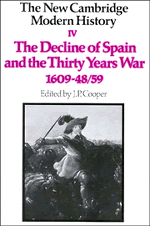Chapter XXIII - Latin America 1610–60
from THE FRONTIERS OF EUROPE
Published online by Cambridge University Press: 28 March 2008
Summary
In 1610 Philip III, Rex Hispaniarum et Indiarum, claimed sovereignty over two great empires in America, one governed from Madrid as part of his crown of Castile, the other governed from Lisbon as part of his crown of Portugal. Together the claimed dominions of the two empires covered all of America, stretching from the yet unknown lands that lay between the Gulf of Mexico and the mysterious Arctic, southward to the equally unknown lands of Tierra del Fuego on the far side of the Straits of Magellan. The territories of the crown of Castile were divided into two viceroyalties: that of New Spain, with its capital at Mexico City, comprised all of the Iberian possessions to the north of Panama, including the islands of the Caribbean and the territory of present-day Venezuela; that of Peru, with its capital at Lima, governed the Castilian possessions from Panama to Chile and Buenos Aires. The American Empire of the crown of Portugal was Brazil, then defined as all land east of the north–south line of demarcation set by the Treaty of Tordesillas, running from the eastern stretches of the Amazon delta to the Island of Santa Catarina on the coast of the present-day Brazilian state of Santa Catarina. This territory was governed by a captain-general at Bahia.
Effective occupation in the form of domination of the native population or direct settlement by Iberian subjects fell far short of Iberian claims, as other European governments did not fail to point out. Nevertheless, the area under effective occupation constituted immense territories. In North America, Spanish dominion touched the present areas of the United States and Canada at two points. In Florida, a small settlement at St Augustine, refounded permanently in 1597, attempted to keep foreign intruders away from the Bahama Channel and the return route of the Spanish fleets, and served as a base for missionary work among the Indians of Florida and Georgia.
- Type
- Chapter
- Information
- The New Cambridge Modern History , pp. 707 - 726Publisher: Cambridge University PressPrint publication year: 1970
- 3
- Cited by



